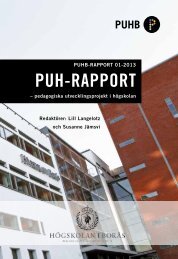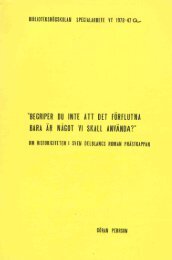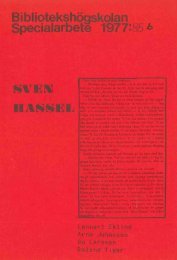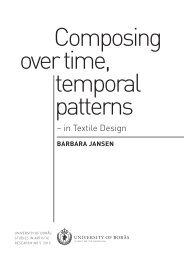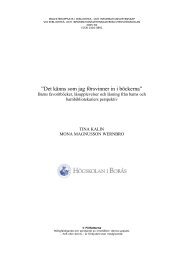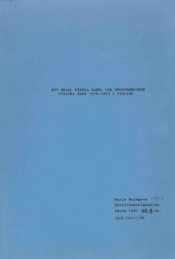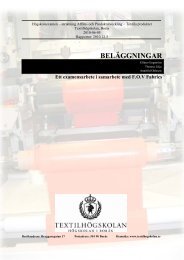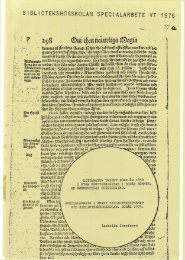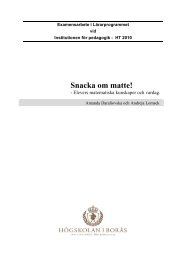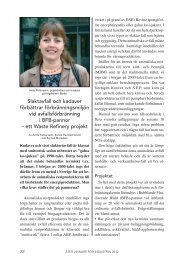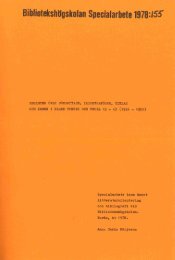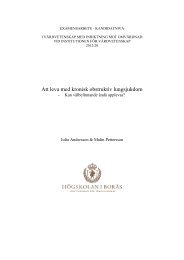KURBITCH! - BADA
KURBITCH! - BADA
KURBITCH! - BADA
Create successful ePaper yourself
Turn your PDF publications into a flip-book with our unique Google optimized e-Paper software.
<strong>KURBITCH</strong>!<br />
-EXPLORING THE STRUCTURE OF ORNAMENT AS DESIGN METHOD<br />
BA IN FINE ARTS; FASHION DESIGN<br />
EMELIE AHLNÉR<br />
MAY, 2013<br />
2013.3.6
INDEX<br />
2 Index<br />
3 Abstract, Keywords<br />
4 -10 Images of work<br />
11-17 Background<br />
- Ornament vs. construction<br />
- Ornamentation in architecture<br />
from pre- to post modernism<br />
- The ornaments’ recurrence<br />
- Architecture and fashion<br />
- Narciso Rodriguez<br />
- Iris Van Herpen<br />
- Giles Deacon<br />
18-19 Aim<br />
-Problem formulation<br />
20 General methods<br />
- Theory and practice<br />
- The role of the artifact<br />
- Experiment as method in design<br />
21-23 Specific methods<br />
- Ways of construction<br />
- Draping on the body<br />
- Kurbits<br />
- Finding form<br />
24-35 Development<br />
- Starting point<br />
- First succeeded experiment<br />
- Light and the reflection of light<br />
- Attracting the eye<br />
- Material<br />
- Extracts from workbook<br />
- Handpainted kurbits on transparent<br />
vinyl with florescent edges<br />
- From figure to structure<br />
- Trousers<br />
- Stylized ornament<br />
- Patterns<br />
- Composition and dynamics<br />
36 Materials<br />
37- 51 Result<br />
52 Discussion<br />
- Evaluation of result<br />
- Scale<br />
- Potential and limitation of method<br />
- “Less is a bore – more is more”<br />
- Ornament or decoration<br />
- Context<br />
- Gaga-feminism<br />
56-57 References<br />
57 Thanks to<br />
58 Appendix<br />
ABSTRACT<br />
In architecture we usually divide built things into structure or ornament. The same way of thinking<br />
can be applied to fashion. First you have a construction (garment) and then you add an ornament, like<br />
a way of styling. This works aim to change that relationship. One way of exploring the relation between<br />
the two concepts is to subordinate structure under ornament in order to change the hierarchy between<br />
form and decoration. Ornaments have in themselves structural elements that can be transformed into<br />
construction. My aim is to find these and let them be the bearing structures when augmenting for new<br />
shapes and expression with a codependent relationship between the two.<br />
The concrete methods of this work have been carried out through experimentation with different<br />
perspective on ornamentation in a trial and error process to achieve new expression and potential of<br />
ornament.<br />
The results are various examples of the design method carried out in different scale and proportions.<br />
They show how the method could be used in a structural way to find form and a more pictorial way to<br />
build expression. It questions modernistic thinking with its form follow function principle and explores<br />
other values such as attraction of the eye and the expression of light reflective materials. It explores the<br />
clash between tradition and new material.<br />
A new discussion could be raised about what is construction and what is ornament, if a separation is<br />
needed or even can be done.<br />
KEYWORDS<br />
Ornament, Structure, Fashion, Architecture, Design, Method,<br />
Decoration, Construction, Kurbits, Expression, Light, Modernism,<br />
Maximalism<br />
2 3
4 5
6 7
8 9
BACKGROUND<br />
Ornament:<br />
1 archaic : a useful accessory<br />
2 a: something that lends grace or beauty<br />
b: a manner or quality that adorns<br />
3: one whose virtues or graces add luster to a place or society<br />
4: the act of adorning or being adorned<br />
5: an embellishing note not belonging to the essential harmony or melody —<br />
called also embellishment, fioritura<br />
Structure:<br />
1: the action of building: construction<br />
2 a: something (as a building) that is constructed<br />
b: something arranged in a definite pattern of organization <br />
(Merriam-Webster 2013)<br />
10 11
Ornament vs. construction<br />
Ornament and construction are often described as a contradicting pair (Sankovitch 1998). Usually we<br />
divide built things into its “skeleton” or structure and its “rags” or ornament. The separation between<br />
these two concepts emerged in the early 20th century with the endless debate about the relationship<br />
between structure and ornament, construction and form, which formed the base for modernist thinking.<br />
Earlier, such a division had been unimaginable. Before that, structure was not considered to be selfsufficient<br />
and ornament was not reduced to a detachable object opposed to structure. Rather, ornament<br />
had a more incorporeal meaning. Whether or not you are for or against ornament, it continues to be<br />
understood as a separate, additional element to structure.<br />
Ornamentation in architecture from pre- to post modernism<br />
In 1856 Owen Jones published “The grammar of ornament - A global and historical design source book”<br />
that consists of 20 chapters with key examples of ornaments from a number of sources, diverse both<br />
historically and geographically. In the preface Jones suggests 37 “general principles in the arrangement<br />
of form and colour in architecture and the decorative arts”. For instance, “Construction should be<br />
decorated. Decoration should never be purposely constructed. That which is beautiful is true, that which<br />
is true must be beautiful.” and, “True beauty results from that repose which the mind feels when the eye,<br />
the intellect, and the affection is satisfied from the absence of any want” (Jones 1856, p. 5).<br />
After the abundance of the ornamentation that characterized the 1800s’ last decades, a strong reaction<br />
was not unexpected, according to Lars Olof Larsson. A short period was characterized by the ambition to<br />
free itself from the historical patterns and create a modern, “contemporary” ornamentation. But shortly<br />
after 1900, the ornament crisis became manifested. One of the strongest proponents of this approach<br />
was the Austrian architect Adolf Loos. In his manifesto “Ornament and Crime”, written 1908, he denies<br />
ornamentation all justification and declares that lack of decoration is the sign of an advanced society<br />
(Larsson 2010, p. 1). According to Loos, any ornament that decorates the human body, the body of a<br />
building or utility objects is there for a reliable indication of criminal energy, childich affectionos, sexual<br />
licentiousness and excessive hedonism (Loschek 2009, p. 180).<br />
A page with examples of moresque ornamnets from Owen Jones “The grammar of ornaments” fig. 1. A doorway of Jules<br />
Lavirotte concidered an Art Nouveau masterpiece, fig 2.<br />
The concept “Form follows function” was introduced by the architect Louis Sullivan and was later<br />
realized consistently as a principle by Bauhaus (Loschek 2009, p. 180). This functionalistic way of<br />
thinking is the basis of modernism that can be attributed to the whole of the twentieth century. The<br />
lack of decorative detail became a hallmark of modern architecture and equated with the moral virtues<br />
of honesty, simplicity and purity. What began as a matter of taste was transformed into an aesthetic<br />
mandate.<br />
Beckman & Ljungström write that during the 20th century’s second half, a countermovement was<br />
formed that questioned modernism’s universality and function. It started first among artists, but quickly<br />
spread to all occupational groups within form and design. The French philosopher and sociologist<br />
Pierre Bourdieu’s studies of human taste preferences from the 1980s supported this movement. They<br />
show that taste is learned rather than innate. What looks like an inherent perception of beauty with<br />
a sense of order and purity is rather the result of internalization that makes us choose for our social<br />
contexts. Bourdieu divides humans into two taste categories: the cultivated, bourgeois, and the folksy,<br />
uncivilized. The bourgeois choose analytically, the folksy emotionally. The bourgeois man’s intellectual<br />
perspective created a good taste that supported the values that Modernism celebrated, while the folksy<br />
man’s emotional way to show their taste was regarded as primitive and its objects as kitschy.<br />
Fig 3. Louis Sullivan’s Wainwright Building. The dormitory building of the Bauhaus school in Dressau, fig 4.<br />
12 13
Fig. 5 The facade of 40 Bond Street, NY by Herzog & de Meuron.<br />
The ornaments’ recurrence<br />
Exactly 100 years after Adolf Loos wrote “Ornament and Crime” that effectively relegated ornament<br />
in architecture to the peripheries of the discourse the ornament is taking its first steps towards its<br />
re-emergence in architectural practice on a global scale. (Domeisen, 2007) Today, the demands of<br />
contemporary capitalist cultures of representation and societal trends towards individual expression<br />
are colliding with the homogenizing modernist idiom. A number of architects are rediscovering a lost<br />
language through which a building can speak to us about more than its own existence.<br />
Words such as appliqué, decoration, ornament and pattern that earlier have been considered as uncivil<br />
or demonstrate a lack of design talent, according to modernistic thinking in the early and mid-twentieth<br />
century, have returned with great force during the beginning of the twenty-first century (Loscheck<br />
2009, p. 197). “Now, even architects Jacques Herzog and Pierre de Meuron, who made their names with<br />
severe Calvinist boxes, transform almost every façade… into complete ornament.”<br />
Architecture and fashion<br />
Architecture and fashion have many similarities. They both provide people with protection and shelter<br />
and are created with the human body in mind (Hodge 2006). Although the end product differs a lot in<br />
scale and material, the creative process is similar in both disciplines. Both the fashion designer and the<br />
architect start with a two-dimensional medium, transforming it to create three-dimensional form. They<br />
share ideological and theoretical foundations and are influenced by the similar tendencies and creative<br />
impulses, resulting in garments and buildings that share stylistic or sculptural qualities. An architectural<br />
vocabulary has been applied to fashion to describe garments as constructed, sculptural or architectural.<br />
In the same way, architects have adapted words and techniques originated from the fashion world, such<br />
as pleating, wrapping and folding of surfaces and material.<br />
Pleats are used as construction in both fashion and architecture, seen here in an example by Junya Watanabe, fig 6 and foreign<br />
office architects, fig 7.<br />
14 15
Narciso Rodriguez<br />
Fig. 8 Fitting in Narciso Rodriguez studio.<br />
According to Hodge (2006, pp. 6, 188), Narciso Rodriguez has been recognized for his development of a<br />
sophisticated minimalist take on women’s wear that owes a great and acknowledged debt to the work<br />
of Mies van de Roche and his “less is more” principle. They are both concerned with the inherent beauty<br />
of structure and construction and his approach to structure echoes, the Bauhaus Schools philosophy of<br />
“form follow function”. “I approach designing a garment in much the same way an architect approaches<br />
designing a building with seaming for structure to create interesting fit lines and shape”, he explains.<br />
Rodriguez follows the lines and curves of the female body to create very precisely fitted garments<br />
without relying on drape or volume to build form. His silhouettes are body close and minimize the<br />
amount of negative space between body and clothing, unlike designers who build silhouettes based<br />
on independent form. Instead he shows of the construction of a garment itself and relies on structural<br />
elements such as a built-in bra or a corset-like bodice to provide shape. He avoids applied or irrelevant<br />
decoration and allows the beauty of seams and dart to serve as his garments’ only decoration. Rodriguez<br />
working method is draping. He rather uses a live model than a mannequin on which to pin and tape<br />
seams and lines in a very precise way to create perfect proportion, balance and fit.<br />
Iris Van Herpen<br />
Van Herpen, on the other hand, works with a sculptural and modern take on haute couture. “Form follows<br />
function is not a slogan with which I concur” says Iris Van Herpen. With a high level craftsmanship, she<br />
mixes old and forgotten techniques with high tech materials and innovation inspired on the world to<br />
come. Her design is closely connected to the female body and by bringing form, structure and material<br />
together, she tries to suggest optimal tension and movement. (http://www.irisvanherpen.com).<br />
Examples of Iris Van Herpens sculptural Haute Couture, fig. 9,10,11. (http://www.irisvanherpen.com).<br />
Van Hepen is an example of when ornament in fashion is used in a large scale. She builds and sculpts<br />
her silhouettes from non-textile materials forming an, architectural shell around the body. They have<br />
a tactile feel from the repetitive use of structure that forms wearable sculptures rather than functional<br />
garments.<br />
Giles Deacon<br />
An example when ornament is used in a smaller scale, more commonly seen in fashion, is Giles Deacons<br />
work from SS12. Silver leather has been laser cut into ornamental patterns in an all over manner or like<br />
decorative applications on dresses, t-shirts and skirts. This is a good illustration of ornament used in an<br />
applied way, only for it’s decorative abilities.<br />
Giles lasercuts from ss12, fig. 12, 13, 14. (http://thecuttingclass.com/post/10801851972/laser-cut-silver-leather-giles)<br />
16 17
AIM<br />
Problem formulation<br />
In fashion minimalism seems to keep us in its iron grip and continues to be viewed as the so called<br />
good taste, I would like to explore a different direction by refusing to see ornamentation as secondary<br />
to construction. I want to change the relation between both concepts and find a way to equate the two.<br />
The aim is to explore the structure of ornament as design method.<br />
This work aims to reintroduce ornaments in a fashion context in the same way that it now finds it way<br />
back in architectural settings. I want to explore how ornamentation can be useful in fashion today. Even<br />
though the ornament is making a come back, ornaments are always subordinated construction. First<br />
you have a construction (garment) and then you add an ornament, like a way of styling. This works aim<br />
to change that relationship.<br />
One way of exploring the relation between the two concepts is to subordinate structure under ornament.<br />
I want to explore what happens if ornament goes from an unnecessary additive element to be the essence<br />
of an outfit? This will be done by letting the ornament lead to form. Ornaments have in themselves<br />
structural elements that can be transformed into construction. My aim is to find these and let them be<br />
the bearing structures when augmenting for new shapes and expression based on ornament.<br />
Another way to look upon the subject is to go back a bit more than 100 years in time, before the<br />
separation of ornamentation and structure was defined according to Sankovitch (1998). By using a<br />
similar way of thinking I want to investigate how ornament in fashion be used more incorporeal in<br />
the same manner that it used to be in architecture before modernist thinking smeared the concept. Is<br />
a separation between the concepts even needed or can they together build new expressions and new<br />
ways to look upon structure and appreciation of decoration?<br />
In Rodriguez work, the structure is visible and functions as decoration of the garment in a minimalistic<br />
manner. By studying the structure of ornament, my intention is to find alternative lines and shapes<br />
as a base for construction and the building of three-dimensional form. And if I like Rodrigez let that<br />
ornamental structure be visible, is that enough for being the garments’ only decoration?<br />
Another aim for this work is to create wearable ornaments, without building the kind of static sculptures<br />
that Van Herpen tends to do. By avoiding draping merely on the mannequin and instead, as Rodriguez<br />
does, use a live model or by draping on myself, my aim is to create garments that interact with the body<br />
in a better way and create interesting shapes and a new expression.<br />
18 19
GENERAL METHODS<br />
Theory and practice<br />
There has already been a separation between theory and practice since the decision to translate epistêmê<br />
and technê into knowledge and art/craft. (Thornqvist 2012, p.9) Translated like this, art is reduced to<br />
a tool or a method for science, not science or knowledge in and for itself. Instead of dealing with the<br />
fundamental development of the field itself, you tend to just “point out problem” and treat artifacts as<br />
products from a textural analysis.<br />
SPECIFIC METHODS<br />
The concrete methods of this work have been carried out through experimentation with different<br />
perspective on ornamentation in a trial and error process to achieve new expression and potential of<br />
ornament. A series of experiment has been carried out where each experiment differ slightly or very<br />
much from the previous. In spite of the differences each new experiment is influenced by the insight<br />
gained from the previous one. The outcome can be seen as arguments for new experiments.<br />
Ways of construction<br />
What Thornqvist suggests is art as science; that result of basic art research is universal and precise,<br />
as well as valid and rigorous. Looking on the history of science experimentation has been used as a<br />
common methodology for exploring and constructing knowledge. Therefore, experimenting as a method<br />
for research within art can be used to state fact and build new knowledge and the artifacts should be<br />
seen as results of this experimentation.<br />
The role of the artifact<br />
What is the role of the artifact in art and design research? This is a question that Michael Biggs is asking<br />
(2004). He argues that objects in themselves cannot account for knowledge. Furthermore, he draws<br />
a parallel to objects in an aesthetic exhibition, which without context leads to the fact that its author<br />
has no control over its reception. And if the aim is to communicate knowledge or understanding, then<br />
deception cannot be an uncontrolled process. This situation is comparable to the meaning of individual<br />
words. Words have meaning in the context of sentences, alongside with other words. What is required<br />
is the combination of artifacts and an exposition that describes how it embodies and contributes to<br />
knowledge, understanding and insight.<br />
Experiment as method in design<br />
When it comes to design research, experimentation can be used as method for producing knowledge in<br />
form. (Brandt & Binder 2007). Experimentation is a scientific method with the goal to establish the validity<br />
of a hypothesis. An early and influential supporter of experimental science was Francis Bacon. In order<br />
for science to be useful, it must be organized, as was Bacon’s proclamation (Nationalencyklopedien). He<br />
suggested that based on a number of events, you could reach a likely conclusion. For Bacon, making is<br />
knowing and knowing is making (Stanford encyclopedia of philosophy).<br />
In a design research driven by design experiments Brandt and Binder argue that the notion of program,<br />
experiment and question is a useful methodological grounding (2007). Design experimentation can be<br />
seen as a means for explore a possible program. The research question guides the investigation of a<br />
concept, while the program set up a frame for the experiments to take place and suggest an applied<br />
method.<br />
The difference from ordinary design work and design research is that in a design work you prove its<br />
relevance through what the program can achieve in terms of finished designs, while in design research<br />
you have to show the strength of the program beyond the individual experiment. For others to gain<br />
from design research it is of great importance to be able to communicate what took place during<br />
experimentation and how it was evaluated.<br />
The most common way of constructing garments is to start from block patterns. These works in that<br />
way that a mathematical system that works with the measurements of the body assists in making a<br />
foundational pattern that later on can be transformed into any kind of garment. One example is Inger<br />
Öberg’s classical learning book (Lindqvist 2013, p. 36).<br />
An alternative approach to construction of garments is Andreas Eklöf’s work presented by Thornqvist<br />
(2012, pp. 74-77). It focuses on the expression of the construction method itself and builds on live<br />
drawings for finding immediate structure and expression of dress. My starting point for construction of<br />
garments has been the ornament. As in the case of Andreas work, I directly translated the ornament into<br />
construction to find structure.<br />
Draping on the body<br />
When it comes to draping, it is of great importance which model you choose. Different suggestions can<br />
be the tailor’s mannequin, a live model or your own body. Each option offers different solutions and<br />
will affect the outcome. When working on the mannequin, you have a neutral pre-model of the body<br />
(Thornquist 2012, p. 82). But one consequence is that the perspective you have standing in front of<br />
the mannequin, as you usually do, will lead to a focus on the front of the upper body, forgetting the<br />
silhouette as a whole. This is a result that can be seen in Van Herpen’s work with shapes that leaves big<br />
parts of the body unexplored and tends to be quite static.<br />
Rodriguez’s use of a live model provides a more fluid way of draping, where the whole body will be<br />
taken in consideration. Another key element here will also be movement since the garment has to relate<br />
to the body in motion.<br />
My choice has been to drape on my own body, which gives a dynamic way of draping with opportunities to<br />
twist and turn the fabric, stepping through holes and openings to explore other possibilities impossible<br />
to achieve on the static mannequin or hard to explain for a live model.<br />
Kurbits<br />
Based on ornamentation and its plethora of variants, my first choice was to focus on the Swedish kurbits.<br />
This choice was the result of my desire to focus on something folkloristic and well-liked by many, to use<br />
an ornament found in homes rather than in churches and other public buildings associated with the<br />
bourgeois and intellectuals. When the term kurbits is used, in this work it aims mainly at the ornaments<br />
as decorative furniture painting on cupboards, shrines and boxes and not to tapestry painting, which<br />
often are illustrations of the Bible.<br />
20 21
From ornament to structure step by step<br />
1. Tools needed for experimentation.<br />
2. Kurbits projected onto a square piece of<br />
fabric.<br />
Finding form<br />
One of the questions in this work was to find new ways to use ornamentation and free it from being<br />
regarded as secondary to construction. An approach to this was to make ornaments into construction.<br />
This succeeded in the way that the outcome shows that it is possible to transform the structure of<br />
ornament into construction.<br />
In the process of making the structure of ornaments into form, the projector has been an important<br />
working tool. A picture of a traditional Swedish kurbits has been projected and traced onto a square<br />
piece of fabric. The next step is to cut out the pattern of the ornament and start to experiment with the<br />
given shape on the mannequin or, more preferably, my own body. When experimenting on my own body,<br />
I find possibilities that are impossible to reach when draping on a mannequin.<br />
What is interesting with this way of building shape is the contrast between the dynamic lines of ornament<br />
and the static square, between the body close and the void. The ornament’s organic lines interact and<br />
embrace the body and discover new paths around it. On the other hand, the square provides with areas<br />
that form into space between body and dress. I started by using a stiff but lightweight non-woven fabric<br />
that enhances the space and is an influential variable in creating this sculptural silhouette.<br />
3. Exploring different possibilities<br />
for the cut out kurbits on myself.<br />
4. First design proposal fitted on mannequin.<br />
When working with this method, intuition has been of great use when choosing which ornament to use<br />
as model for experiment. I can predict most likely if a certain ornament will work in a structural way<br />
or not, even if I cannot say what garment it will form. This is determined in the next step of the process<br />
when I start to experiment on my own body. A garment is held up either by resting on the shoulders or<br />
the hips. Therefore, the decision to put my head through a hole formed by the cut out ornament leads to<br />
the fact that it most likely will turn out as an upper garment such as a top, jacket, coat or dress, unlike<br />
the choice to make the hole a bit bigger and place it at the waist, which then will form a skirt or a pair<br />
of trousers.<br />
5. Modification of pattern. 6. Second design proposal fitted on mannequin.<br />
Another factor in the determination of garment, according to this method, is how big a square the<br />
ornament is placed upon. A smaller square will lead to a jacket or a short dress, in contrast to a bigger<br />
square which will lead to a full-length dress or a coat. In the beginning of my process, this was made<br />
completely by chance, as the choice of ornament. But the further I went in my experimentation, I<br />
learned to understand the relationship between size and shape of the ornament in contrast to the size<br />
of the square. This understanding allowed me to control my process, if not completely, then at least a bit<br />
towards a planned outcome.<br />
7. Different material tested and evaluated, here<br />
denim strengthened with wooden glue solution.<br />
8. Later the design changed into the jacket presented<br />
in outfit 3. Final prototype.<br />
22 23
DEVELOPMENT<br />
Starting point<br />
When starting experimenting with ornaments, a question of scale was raised. When it comes to ornament<br />
in fashion, it is almost always used in small or medium scale, more in an all-over manner. Therefore it<br />
was hard for me to challenge my perception of how big an ornament on body could be. In the beginning<br />
my experiments were in small scale. A breaking point was when I tried a square piece of fake fur with<br />
a cut out kurbits on a small scale wooden doll. Proportions of ornament on body suddenly shifted from<br />
very small to very big. With this in mind I continued by using the projector to experiment with ornament<br />
on body in various scale.<br />
First succeeded experiment<br />
My first experiment of projecting an ornament upon a square was towards an unplanned result, means<br />
I had no garment in mind. After cutting out the ornament I placed my head through a hole in the middle<br />
and got an immediately result in form of an apron like dress. This experiment can be seen in the first<br />
outfit of the line up. Almost no alteration has been done except change of material a scalloped edge has<br />
been added. This was my first step in developing a method from the structure of ornament.<br />
24 25
Early experiments with red LED, flashing rgb LED and fibers optics.<br />
Installing LED in light jacket for outfit 5.<br />
Light and the reflection of light<br />
Some of my early material experiments involved a pattern of LED on a transparent, florescent vinyl,<br />
an experiment with flashing LED and fiber optics and a cut out lace on the florescent vinyl. Loschek<br />
writes that light is a means used to achieve colour and patterns not only in architecture, but also in<br />
experimental clothing (2009, p. 67). Experiments with LED integrated into clothes or applied to as<br />
decorative necklaces or bracelets as well as fluorescing fabrics attract attention, at catwalk presentation<br />
in particular.<br />
A selection of material used in the collection.<br />
First line from left: Silver sequins, transparent florescent vinyl, moon dust coated pvc.<br />
Second linde: florescent neon plexi glass.<br />
Third line: Radiant film, holographic sequins, silver glitter coated pvc.<br />
Attracting the eye<br />
Tapparelli writes about Bronze shavings as ornament when scattered over a horizontal surface. (2007,<br />
23). Bronze shavings is an industrial by-product that take on the function of an ornamental motif in that<br />
they attract the eye and hold the attention of the viewer.<br />
My experiments led to developing a glitter jacket with 200 tassels made of fiber optics and formed into<br />
a figure of a kurbits on both the front and back of the jacket. Each tassel was provided with a flashing<br />
RGB LED behind. The outcome is the rather hysterical, eye catching jacket in outfit 5. It is an applied<br />
way of using ornament but successful in the way that the flashing tassels both provides with pattern<br />
and three-dimensional form.<br />
Since the purpose of ornament is to beautify and attract one’s gaze, I thought it was suitable for this<br />
work to experiment with light which demands the attraction of the eye. This was later reduced into find<br />
and use materials that is light reflecting, florescent or in other ways shines such as radiant film, glitter<br />
coated fabric, sequins and fluorescent plexi glass. This can be seen as an interpretation to create a similar<br />
surface as the bronze scattered ones Tapparelli talks about.<br />
26 27
a. Moon dust coated pvc fused together<br />
with rubber like material commonly used<br />
as padding between table and tablecloth<br />
Material<br />
b. Glitter coated pvc fused together<br />
with non woven fabric commonly<br />
used as backing for pads for office<br />
furniture.<br />
c. Denim stiffened with wodden glue<br />
solution made out from 1 part wodden<br />
glue, 5 parts water.<br />
One of the challenges in my choice of material has been the fact that my shapes are dependent on certain<br />
strength in material. It has to be light-weighted, yet vigorous to support form. As a starting point,<br />
a grey non-woven fabric used as backing for pads for office furniture was used. I was pleased with the<br />
sculptural silhouettes achieved with this material. Therefore, the challenge was to imitate that material<br />
and create new ones with the same possibilities. I have worked with stiffer material in different kind of<br />
ways. The light glitter fabrics have been fused together with a non-woven fabric that offered the same<br />
properties and the lilac glitter fabric together with the grey non-woven fabric. For the same reason,<br />
the jeans have been strengthened with a wooden glue solution. Both ways give the ability to achieve<br />
raw edges that does not fringe, which is necessary for making the different shaped edges I have used<br />
throughout the collection.<br />
Extracts from workbook<br />
To challenge my method a series of experiment was executed. The relationship between the scale<br />
of the ornament and the square was tested and evaluated. The coat in outfit 4 is a result of a series<br />
of experiments seen above. Here I wanted to get a result which would cover more of the body than<br />
earlier experiments. Therefore I started of using a square of appropriate size and chose an ornament<br />
that I thought would be interesting for creating three-dimensional form. My main argument for this<br />
was the arch as you can see in the picture of the kurbits used as model. The result was pleasing and<br />
various alternation and tryouts in different material was made before getting to final result. The other<br />
experiment seen above was made to really challenge the scale and relationship between ornament/<br />
square. I chose to project a kubits onto almost 4 meter of fabric with full with. This turned out in a fulllength<br />
dress with trail. The result was not as pleasing as previous mentioned since the large square (or<br />
rectangle) is providing with to much extra material that is not able to create form.<br />
28 29
From figure to structure<br />
1. Original kurbits painting on cabinet. (byt bild) 2. Transfer print on dress.<br />
3. CAD file for laser cutting.<br />
4. Accesoar in plexi glass with florescent edges for outfit 1.<br />
Handpainted kurbits on transparent vinyl with florescent edges<br />
In this experiment my aim was to use ornament more traditionally way. Since kurbits usually is<br />
handpainted on cupboards, shrines and boxes as a decorative element I wanted to use the same technique<br />
but on an unconventional material. I started experiment with paint on a neon pink transparent vinyl<br />
with florescent edges and found out that some colours gave a glowing effect on the surface when seen<br />
from the back. I used that to handpaint a kurbits, like a front print, on a t-shirt. The result shows an<br />
interesting clash between traditional technique and use of ornament on new expressional material.<br />
This additive way of using ornaments can be seen as the background represented in this work or as an<br />
attempt to enhance it’s traditional usage.<br />
5. Duplication for projection. 6. Kurbits skirt for outfit 2.<br />
30 31
Trousers<br />
When trying my method on trousers I encounter problems. I can’t decide if it is the shape or scale of the<br />
cut out ornament or the size of the square that is the problem. I have a hard time figure out how to use<br />
the structure of the ornament in a fruitful way. After experimenting with different kind of ornaments as<br />
a base fore structure I give up.<br />
A proposal for a solution to the problem comes up when doing another experiment. When starting<br />
working with this ornament I already have trousers in mind. Therefore I choose a stylized ornament and<br />
also the scale and placing on the square with a planned outcome for the experiment. Earlier experiments<br />
has been more random when it come to scale and placing of the ornament, letting the method lead to<br />
form without having a specific garment or garment type in mind. This is a more applied way of using the<br />
method and can also bee seen as more decorative way of using the method. The outcome is different,<br />
good or bad can be debated.<br />
Stylized ornament<br />
As mentioned on previous page the outcome for this particular experiment was to be a pair of trousers.<br />
But when experimenting with the ornament on body I find other possibilities like skirt or dress. Since I<br />
find the structure of this ornament a bit easier to read than others I decide to make a dress out of it. The<br />
dress will be made in a holographic radient film.<br />
32 33
Composition and dynamics<br />
The line up is the result of various experiments where each outfit can be seen as parts of a whole.<br />
The result contains examples where ornament has been dealt with in different ways and in different<br />
scales, figurative or structural, from a small decorative edge to an ornament covering the entire body. A<br />
selection has been made with dynamics in mind.<br />
Patterns for dress in outfit 6 and jacket in outfit 7.<br />
The dynamic inherent in any particular shape, color, or movement can make its presence felt only if it<br />
fits the comprehensive dynamics of the total composition (Arnheim 1954, p. 432).<br />
When dealing with the fact that most of my materials and shapes are very expressive, question have<br />
been raised such as if I need to tone down and add neutrals to find dynamics in color, material and shape.<br />
My respond to this has been to not to work with neutrals but instead work with various proportions of<br />
these elements to find dynamics.<br />
34 35
MATERIALS<br />
RESULT<br />
36 37
OUTFIT 1<br />
Denim apron dress with scallop edge<br />
Body in holographic sequins<br />
Shorts in holograpic sequins with scallop edge<br />
Necklace in florocent plexi glas<br />
38 39
OUTFIT 2<br />
T-shirt in transparent vinyl with florecent cut<br />
scallop edge<br />
Ornamental skirt in moon dust coated pvc fused<br />
together with rubberlike table felt<br />
Underskirt in holographic sequins<br />
40 41
OUTFIT 3<br />
Jacket in grey non-woven fabric and radiant film<br />
Skirt in grey non-woven fabric and radiant film<br />
42 43
OUTFIT 4<br />
Coat in glitter coated lavender denim fused together<br />
with grey non-woven fabric. with scallop edge<br />
Shorts in silver sequins with scallop edge<br />
44 45
OUTFIT 5<br />
Jacket in glitter coted pvc with tassels of fiber optics<br />
and flashing RGB LED with scallop edge<br />
Chaps in glitter coated pvc with scallop edge<br />
Shorts in silver sequins with scallop edge<br />
46 47
OUTFIT 6<br />
Ornamental dress in radiant film<br />
Body in sequins<br />
48 49
OUTFIT 7<br />
Jacket in moon dust coated pvc fused together<br />
with rubberlike table felt with scallop edge<br />
Trousers in moon dust coated pvc with scallop<br />
edge<br />
50 51
DISCUSSION<br />
This work concern the possibilities with ornamentation as design method, freeing the ornament of being<br />
subordinated construction and find its inherent structural element and let them lead to form. It<br />
questions modernistic thinking with its form follow function principle and explores other values such<br />
as attraction of the eye and the expression of light reflective materials. It explores the clash between<br />
tradition and new material.<br />
The results are various examples of the design method carried out in different scale and proportions.<br />
They show how the method could be used in a structural way to find form and a more pictorial way to<br />
build expression. They argue for a more intergraded way to work with the concepts of structure and<br />
ornament and highlight the discussion of decorative work in fashion.<br />
In my analysis and reflections over this work I will discuss it from some different perspectives and pin<br />
point some of the questions raised during design seminars and in the critique I got after presenting my<br />
work for the opponent. I will discuss some possible ways to develop the work further and try to place<br />
the work within a context.<br />
Evaluation of result<br />
After having presented a final proposal for a complete line up, one can come to some conclusions. The<br />
first one is that expression is strongest when working monochrome in material and colour and in an<br />
overall manner as you can see in outfit 4, 6 and 7. When trying to balance shapes and expression with<br />
“normal” garment and material such as shirt and jeans the outcome gets messy and unclear as in outfit<br />
1, 3 and 5. They do not complement the garments built by ornamental structure in a supporting way but<br />
instead lower the outfits overall expression. These pieces has been removed, except from denim, as a<br />
material, in outfit one, and replaced with under garments made out of matching sequins to each outfit.<br />
Also the necklace has been moved from outfit 3 to 1 to create a more monochrome unit-by-unit feel to<br />
the collection as a whole.<br />
Scale<br />
By experimenting with the ornament in different scale, my aim was to investigate its inherent aesthetic<br />
values in various ways. An experiment with the same object in different scale in relationship to the<br />
body can show how form and fit can challenge our perspective of dress and its interaction with the<br />
body (Thornqvist 2012, p. 48). When working with the ornament as design method for creating threedimensional<br />
form, the scale of the ornament is so big that it covers parts or the entire body.<br />
One assumption for working with ornaments in small scale, yet not in a figurative manner, is the<br />
edge that has been cut like an ornamental framing to the whole garment. An intermediate between<br />
these can be seen when I have worked with ornaments in a figurative way more than in a traditional<br />
decorative manner, such as the hand painted kurbits in outfit 2, the necklace in outfit 1 or in the overall<br />
ornamentation made out of flashing LED and fiber optics in outfit 5.<br />
Potential and limitation of method<br />
This method has great potential for finding new form and expression within fashion. The work shows<br />
how it is possible to use the structure of the ornament as a base for building shape. You can use the<br />
method in different scale to create different garments and it is also possible to reduce the forms made<br />
into more understandable garments. It would be interesting to continue to challenge the scale between<br />
the static square and the organic ornament to see what expression can be made at its most extreme.<br />
The problems encountered when trying to make trousers were dealt with and a pair of chaps was made<br />
to show that it is possible to make trousers from the method. I still think that this could be developed<br />
further.<br />
A consequence when working with this method is that since it is built upon cut out holes, it leaves<br />
part of the body revealed. This means that it needs complementing undergarments which only purpose<br />
is to cover the body. In the final result the problem is solved by matching garments underneath the<br />
ornamental pieces, as a blank canvas, on which they can speak for themself. But it would be interesting,<br />
as a next step, to continue to develop the method further and integrate the two element more so it could<br />
be self-sufficient.<br />
Since the method is relying on the structure of ornament to create form. A interesting question can be<br />
raised on when is it construction and when is it ornamentation, if a separation is needed or even can be<br />
done.<br />
52 53
“Less is a bore – more is more”<br />
When talking about aesthetics, it is hard to be impartial. Through history, many philosophies have<br />
evolved, regarding what beauty is. Loschek describes aesthetics in design as the exclusive aim for the<br />
product as such rather than technology or functionalism (2009, p.95). She quotes Manfred Schmalriede:<br />
“The aesthetic emerges as an organizing pattern, the construction of which is defined according to<br />
our perception. Since we have no access to the processes of our perception, all that remains are the<br />
products, whose patterns can we altered through reflection. We experience the “aesthesis”, the sensual<br />
perception, as a standardized phenomenon. To perceive an object, an event, an action or a situation as it<br />
is, as opposed to all the associations that point beyond it, constitutes an aesthetic moment.”<br />
Rodriguez’s work echoes Bauhaus’s “less is more” principle. Van Herpen refuses the same concept and<br />
works with the contrary. My work is much more into “more is more” but I am still striving for balance,<br />
but maybe a maximalistic one.<br />
One matter regarding aesthetic when working in a maximalistic manner is that the forms achieved from<br />
making construction out of ornaments is quite complex, and question needs to be raised on when and<br />
how forms can be simplified into more understandable shapes and wearable garments. The only way<br />
to make those decisions is to start from the only constant: the making of clothing, the body. Only there,<br />
important factors, such as wearability, comfort, garment in motion, and the aesthetic expression overall,<br />
can be evaluated.<br />
Ornament or decoration<br />
It is hard to distinguish the terms ornament and decoration. All ornament is decorative but not all<br />
decoration is ornament. Ornament exists beyond the rules of decorum. (Domeisen 2008, p. 9). McNicholas<br />
discusses the definition between the concepts based on definitions of the two words in The Oxford<br />
English Dictionary. It defines ornament as “primarily functional, but also fancy or decorative” The word<br />
derives from the Latin “ornare” which translates as “to honor or adorn.” Ornament can be described as<br />
a manifestation of beauty or what makes beauty visible. He quotes Thom Phillips who wrote “Ornament<br />
serves strength with strength. It is not an afterthought as is decoration. It is not merely applied but<br />
becomes one with the object it helps create.” It is not just an addition to a functional object in order<br />
to make it more attractive. The definition of decoration according to the OED is “an embellishment<br />
temporarily put up on some special occasion.” Ornament and decoration are both celebrate visual<br />
pleasure but decoration implies grandeur of little consequence, because it is changed easily, while<br />
ornament implies purpose and celebration of function (McNicholas 2006, pp. 4-7).<br />
Translated into fashion this means that the difference between ornament and decoration is how<br />
incorporated the element is in the garment, if it has structural values or if it is just an additive element<br />
placed upon the garment as an afterthought. In the final result you can look upon the painted kurbits on<br />
the vinyl T-shirt in outfit 2 as an example of decoration where as in garment such as the denim apron<br />
dress in outfit 1, the coat in outfit 4 or the chaps in outfit 5 is just some examples of when the kurbits<br />
has been used as ornamentation in a structural manner.<br />
Context<br />
A recurring discussion about my work has been in which context it is taking place. It has been hard for<br />
others to see it in a commercial setting and my aim has never been to position in that field. I can see a<br />
possible use for my work within stage and performance, the garments could be used in a music video<br />
for example. My goal for this collection is also to not only make an editorial photo-shoot but also to<br />
work with film. I think it would be interesting to take my collection one step further and present it in<br />
a scene and create a holistic experience. I want to create a fashion fantasy that pushes the boundaries<br />
for conventional thinking.<br />
When talking about context I also think you can se parallels between this collection and Japanese<br />
street style Kawaii. Cute or Kawaii began with the young in Japan during the 1970’s. (Clark 2012, pp.<br />
373-374). It was soon picked up by brands such as Sanrio who is the maker of the iconic Hello Kitty.<br />
Other styles as the “Lolitas”, with its bows, frills and laces, all in pink, followed. Japanese subculture<br />
is full of different styles extreme in expression. Fashion, popular culture, street style, garment, image,<br />
music are so combined that distinctions of “high” and “low” become meaningless.<br />
Within the genre it is common to build your style upon a character, or more or less be that character.<br />
Like the Gothic/Punk music duo Hitomi Yoshizawa and Rika Ishikawa, or Hangry and Angry, who like<br />
Hello Kitty also is animated cats origins from comic-books. As I see my collection, I have a character<br />
in mind. When starting to communicate about the expression that I searched for it was hard for me to<br />
describe it, a description that recurred was “Angry My Little Ponys on speed”. It is glittery and pink,<br />
ornamental and feminine but it is also angry and provocative, strong and daring. This is a revolt, a<br />
statement as a contrary to modernistic thinking and aesthetics, but also against what I consider an<br />
overly stereotypical view of feminism. It could be seen as an expression for the new Gaga-feminism.<br />
Gaga-feminism<br />
Lady Gaga is a symbol for a new kind of feminism (Halberstam, 2013). She is a master of media manipulation,<br />
a sign of a new world disorder, and a loud voice of different arrangement of gender, sexuality,<br />
visibility and desire. We can use the world of Gaga to question new femininities. This punk feminism<br />
hits at a future and gestures toward new forms of revolt. Gaga feminism tracks a version of feminism<br />
that will not settle for banal accounts of women striking out for independence and becoming powerful<br />
in the process. This version of feminism are not “becoming women” in the sense of coming to<br />
consciousness, they are unbecoming women in every sense – they undo the category, they play with it,<br />
take it apart like a car engine and then rebuild it so that it is louder and faster.<br />
54 55
REFERENCES:<br />
Arnheim, Rudolf (1974). Art and visual perception: a psychology of the creative eye. The new version,<br />
expanded and rev. ed. Berkeley: Univ. of California P.<br />
Brandt, E & Binder, T (2007). Experimental design research: genealogy – intervention – argument´<br />
Proceedings of the International Accociation of Societies and Design Research, Hong Kong<br />
Biggs, M (2002). `The Role of the Artifact in Art and Design Research´ International Journal of Design<br />
Sciences and Technology. 10(2)(2), 1´9-24.<br />
Cousins, M, Maak, N, Basar, S, Steele, B, Bloomer, Tapparelli, C, K, Domeisen, O (eds) (2008). S AM N° 05<br />
ORNAMENT NEU AUFGELEGT / RE-SAMPLING ORNAMENT, Basel: Christoph Merian Verlag<br />
Hazel, C (2012) Exhibition review: Japan Fashion Now, Fashion Theory: The journal of dress, body and<br />
culture, Vol. 16, no. 3 <br />
Halberstam, J (2013) Gaga feminism sex, gender and the end of normal. Boston: Beacon Press<br />
Hodge, B & Mears, P (2006). Skin + bones: parallel practices in fashion and architecture. Los Angeles:<br />
Museum of Contemporary Art<br />
Iris van Herpen (2013) http://www.irisvanherpen.com/ [2013-05-01]<br />
Jones, O (2001[1856]). The grammar of ornament: illustrated by examples from various styles of ornament.<br />
London: Dorling Kindersley<br />
Larsson, L O (2010). `Ornament och ornamentstick från renässans till nyklassicism´ Humanistportalen,<br />
<br />
[2013-04-27]<br />
Lindqvist, R (2013). On the logic of pattern cutting Borås: CTF<br />
Sankovitch, A-M (1998). `Structure/ornament and the modern figuration of architecture´, The Art Bulletin,<br />
vol. 80, no. 4, [2013-05-02]<br />
Stanford encyclopedia of philosophy (2013). Francis Bacon http://plato.stanford.edu/entries/francis-bacon/<br />
[2013-05-03]<br />
Thornquist, C (2012). Arranged abstraction definition by example in art research. Borås: CTF<br />
IMAGE REFERENCES:<br />
Fig. 1 http://unit607.com/The-Grammar-of-Ornament<br />
Fig. 2 http://www.parisperfect.com/blog/2011/03/art-nouveau-7th-arrondissement/<br />
Fig. 3 http://commons.wikimedia.org/wiki/File:Louis_Sullivan_-_Wainwright_Building,_Seventh_%2B_<br />
Chestnut_Streets,_Saint_Louis,_St._Louis_City_County,_MO.jpg<br />
Fig. 4 http://www.archdaily.com/87728/ad-classics-dessau-bauhaus-walter-gropius/<br />
Fig. 5 http://coolboom.net/products/40-bond-gate-by-herzog-and-de-meuron/<br />
Fig. 6 http://www.artnet.com/magazine/news/newthismonth/ntm12-3-2a.asp<br />
Fig. 7 http://www.uel.ac.uk/risingeast/archive05/essays/donald.htm<br />
Fig. 8 http://www.narcisorodriguez.com/inspiration<br />
Fig. 9, 10, 11 http://www.irisvanherpen.com/<br />
Fig. 12, 13, 14 http://thecuttingclass.com/post/10801851972/laser-cut-silver-leather-giles<br />
Loschek, I (2009). When clothes become fashion design and innovation systems. Oxford: Berg<br />
THANKS TO:<br />
McNicholas, M (2006). `The relevance and transcendence of ornament: a new public high school for<br />
the south side of Chicago’, Master thesis, Graduate School of the University of Notre Dame,<br />
My Family<br />
<br />
[2013-05-27]<br />
Clemens Thornqvist<br />
Ulrik Martin Larsen<br />
MD13<br />
Merriam–Webster (2013). Ornament, Structure. [2013-05-02]<br />
Daniel Larsson<br />
Erik Josefsson<br />
56 57
APPENDIX<br />
Critique of Lina Ericssons work Denimized<br />
Firstly I have to say that I had some problem doing a proper opposition on Linas’ work since the report<br />
contains many gaps regarding important parts of the work in both its method, development and result<br />
that will be added by Lina later on. My critique however is based on the report as it was given to me.<br />
Lina has an interesting concept and aim for her work that is of much relevance for the fashion industry<br />
today where denim wear is always represented in the passing trends and right now feels very relevant.<br />
She has done an extensive research both in theory and practise regarding denim, its archetypes, the<br />
history and the use of denim in the fashion of today.<br />
Lina wants to blend the two areas of textile and fashion design. She has put a lot of effort on textile and<br />
surfaces and less in form, therefore I feel that the work sometimes lacking in those areas. Lina has done<br />
a great job with her material experiments adding a new and very appealing textile surface to denim. I<br />
think the contrast between material and technique is important and well executed in the examples with<br />
glitter on denim and less expressive in the needle punched manipulated examples, like the pink skirt for<br />
example. A suggestion is to blend the wool with some other shiny fibres, similar to the ones she has used<br />
in some of her material experiments (fig. 14, 16, and 18).<br />
Lina has used the denim archetypes as a base for her work and used them in different scale to find new<br />
form. I think that she could have been more daring and challenged the scale even more. Complementing<br />
material and garments to the denim pieces is important for Linas’ work and here I think that there is<br />
not as much emphasis put in as into the denim. Heavy knits are a good and suitable choice but could<br />
be made stronger by adding another element. It would be interesting if Lina went on with her material<br />
experiments on knitted materials. What happens if you fuse them together with other materials or use<br />
the needle punch technique on knits? I really like the glitter coating used in the dungaree dress, maybe<br />
that could be used on jersey to create a complementing material to use in t-shirts and tank tops? Could<br />
you do crossovers between knit and denim, like doing the denim archetypes in a knitted material, like<br />
the teddy she has used in the skirt in outfit one? Another suggestion is to the sequin embroidery on<br />
the jersey pieces in the same way that people working with denim wear use print as a complementing<br />
element in their collections.<br />
Jacket made into vest,<br />
scaled up.<br />
Jersey top with glitter<br />
coating.<br />
Knitted “denim” skirt.<br />
58<br />
Bustier from outfit 5.<br />
Trousers made longer.<br />
Jacket scaled up. Jacket from outfit 1,<br />
made in terry knit<br />
instead.<br />
Added patches on<br />
jeans from earlier<br />
sketch, but in an<br />
allover manner.<br />
Glitter fibre added on<br />
needle punched skirt.



